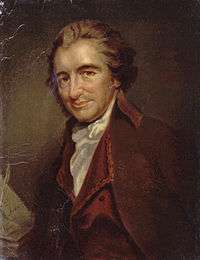Thomas Paine
Thomas Paine (born Thomas Pain[1]) (February 9, 1737 [O.S. January 29, 1736][Note 1] – June 8, 1809) was an English-born American political activist, philosopher, political theorist, and revolutionary. He authored the two most influential pamphlets at the start of the American Revolution and inspired the patriots in 1776 to declare independence from Great Britain.[2] His ideas reflected Enlightenment-era ideals of transnational human rights.[3] Historian Saul K. Padover described him as "a corsetmaker by trade, a journalist by profession, and a propagandist by inclination".[4]
Thomas Paine | |
|---|---|
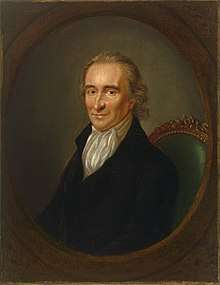 Portrait by Laurent Dabos (c. 1792) | |
| Born | Thomas Pain February 9, 1737 Thetford, Norfolk, Kingdom of Great Britain |
| Died | June 8, 1809 (aged 72) |
| Spouse(s) | Mary Lambert (m. 1759) Elizabeth Ollive (m. 1771; separated 1774) |
| Era | Age of Enlightenment |
| School | Liberalism Republicanism |
Main interests | Politics, ethics, religion |
Influences
| |
Influenced
| |
| Signature | |
Born in Thetford in the English county of Norfolk, Paine migrated to the British American colonies in 1774 with the help of Benjamin Franklin, arriving just in time to participate in the American Revolution. Virtually every rebel read (or listened to a reading of) his powerful pamphlet Common Sense (1776), proportionally the all-time best-selling[5][6] American title, which catalysed the rebellious demand for independence from Great Britain. His The American Crisis (1776–1783) was a pro-revolutionary pamphlet series. Common Sense was so influential that John Adams said: "Without the pen of the author of Common Sense, the sword of Washington would have been raised in vain".[7] Paine lived in France for most of the 1790s, becoming deeply involved in the French Revolution. He wrote Rights of Man (1791), in part a defense of the French Revolution against its critics. His attacks on Anglo-Irish conservative writer Edmund Burke led to a trial and conviction in absentia in England in 1792 for the crime of seditious libel.
The British government of William Pitt the Younger, worried by the possibility that the French Revolution might spread to England, had begun suppressing works that espoused radical philosophies. Paine's work, which advocated the right of the people to overthrow their government, was duly targeted, with a writ for his arrest issued in early 1792. Paine fled to France in September where, despite not being able to speak French, he was quickly elected to the French National Convention. The Girondists regarded him as an ally. Consequently, the Montagnards, especially Maximilien Robespierre, regarded him as an enemy.
In December 1793, he was arrested and was taken to Luxembourg Prison in Paris. While in prison, he continued to work on The Age of Reason (1793–1794). James Monroe, a future President of the United States, used his diplomatic connections to get Paine released in November 1794. Paine became notorious because of his pamphlets. The Age of Reason, in which he advocated deism, promoted reason and free thought and argued against institutionalized religion in general and Christian doctrine in particular. He published the pamphlet Agrarian Justice (1797), discussing the origins of property and introduced the concept of a guaranteed minimum income through a one-time inheritance tax on landowners. In 1802, he returned to the U.S. When he died on June 8, 1809 only six people attended his funeral as he had been ostracized for his ridicule of Christianity.[8]
Early life and education
Thomas Paine was born on January 29, 1736 (NS February 9, 1737),[Note 1] the son of Joseph Pain, a tenant farmer and stay-maker,[9] and Frances (née Cocke) Pain, in Thetford, Norfolk, England. Joseph was a Quaker and Frances an Anglican.[10] Despite claims that Thomas changed the spelling of his family name upon his emigration to America in 1774,[1] he was using "Paine" in 1769, while still in Lewes, Sussex.[11]
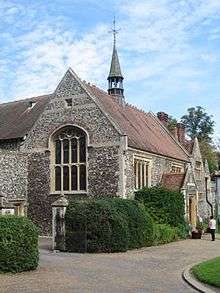
He attended Thetford Grammar School (1744–1749), at a time when there was no compulsory education.[12] At the age of 13, he was apprenticed to his father, a staymaker.[13][14] Following his apprenticeship, aged 19, Thomas enlisted and briefly served as a privateer,[15] before returning to Britain in 1759. There, he became a master staymaker, establishing a shop in Sandwich, Kent.[16]
On September 27, 1759, Thomas Paine married Mary Lambert. His business collapsed soon after. Mary became pregnant; and, after they moved to Margate, she went into early labour, in which she and their child died.[17]
In July 1761, Paine returned to Thetford to work as a supernumerary officer. In December 1762, he became an Excise Officer in Grantham, Lincolnshire; in August 1764, he was transferred to Alford, also in Lincolnshire, at a salary of £50 per annum. On August 27, 1765, he was dismissed as an Excise Officer for "claiming to have inspected goods he did not inspect". On July 31, 1766, he requested his reinstatement from the Board of Excise, which they granted the next day, upon vacancy. While awaiting that, he worked as a stay-maker.[18]
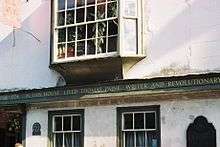
In 1767, he was appointed to a position in Grampound, Cornwall. Later he asked to leave this post to await a vacancy, and he became a schoolteacher in London.
On February 19, 1768, he was appointed to Lewes in Sussex, a town with a tradition of opposition to the monarchy and pro-republican sentiments since the revolutionary decades of the 17th century.[19] Here he lived above the 15th-century Bull House, the tobacco shop of Samuel Ollive and Esther Ollive.[20]
Paine first became involved in civic matters when he was based in Lewes. He appears in the Town Book as a member of the Court Leet, the governing body for the town. He was also a member of the parish vestry, an influential local church group whose responsibilities for parish business would include collecting taxes and tithes to distribute among the poor. On March 26, 1771, at age 34, he married Elizabeth Ollive, his landlord's daughter.[21]
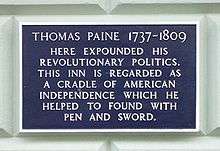
From 1772 to 1773, Paine joined excise officers asking Parliament for better pay and working conditions, publishing, in summer of 1772, The Case of the Officers of Excise, a 12-page article, and his first political work, spending the London winter distributing the 4,000 copies printed to the Parliament and others. In spring 1774, he was again dismissed from the excise service for being absent from his post without permission; his tobacco shop failed, too. On April 14, to avoid debtors' prison, he sold his household possessions to pay debts. On June 4, 1774, he formally separated from his wife Elizabeth and moved to London, where, in September, mathematician, Fellow of the Royal Society, and Commissioner of the Excise George Lewis Scott introduced him to Benjamin Franklin,[22] who suggested emigration to British colonial America, and gave him a letter of recommendation. In October, Paine emigrated to the American colonies, arriving in Philadelphia on November 30, 1774.[23]
In Pennsylvania Magazine
Paine barely survived the transatlantic voyage. The ship's water supplies were bad and typhoid fever killed five passengers. On arriving at Philadelphia, he was too sick to disembark. Benjamin Franklin's physician, there to welcome Paine to America, had him carried off ship; Paine took six weeks to recover. He became a citizen of Pennsylvania "by taking the oath of allegiance at a very early period".[24] In March 1775, he became editor of the Pennsylvania Magazine, a position he conducted with considerable ability.[25]
Before Paine's arrival in America, sixteen magazines had been founded in the colonies and ultimately failed, each featuring substantial content and reprints from England. In late 1774, Philadelphia printer Robert Aitken announced his plan to create what he called an "American Magazine" with content derived from the colonies.[25] Paine contributed two pieces to the magazine's inaugural issue dated January 1775, and Aitken hired Paine as the Magazine's editor one month later. Under Paine's leadership, the magazine's readership rapidly expanded, achieving a greater circulation in the colonies than any American magazine up until that point.[25] While Aiken had conceived of the magazine as nonpolitical, Paine brought a strong political perspective to its content, writing in its first issue that "every heart and hand seem to be engaged in the interesting struggle for American Liberty."[25]
Paine wrote in the Pennsylvania Magazine that such a publication should become a "nursery of genius" for a nation that had "now outgrown the state of infancy," exercising and educating American minds, and shaping American morality.[25] On March 8, 1775, the Pennsylvania Magazine published an unsigned abolitionist essay titled African Slavery in America.[26] The essay is often attributed to Paine on the basis of a letter by Benjamin Rush, recalling Paine's claim of authorship to the essay.[26] The essay attacked slavery as an "execrable commerce" and "outrage against Humanity and Justice."[26]
Consciously appealing to a broader and more working class audience, Paine also used the magazine to discuss worker rights to production. This shift in the conceptualization of politics has been described as a part of "the 'modernization' of political consciousness," and the mobilization of ever greater sections of society into political life.[25][27][Note 2]
American Revolution
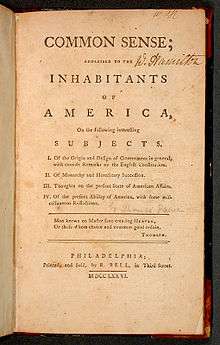
Common Sense (1776)
Paine has a claim to the title The Father of the American Revolution,[28][29] which rests on his pamphlets, especially Common Sense, which crystallized sentiment for independence in 1776. It was published in Philadelphia on January 10, 1776, and signed anonymously "by an Englishman". It became an immediate success, quickly spreading 100,000 copies in three months to the two million residents of the 13 colonies. During the course of the American Revolution, a total of about 500,000 copies were sold, including unauthorized editions.[5][30] Paine's original title for the pamphlet was Plain Truth, but Paine's friend, pro-independence advocate Benjamin Rush, suggested Common Sense instead.[31]
The pamphlet came into circulation in January 1776, after the Revolution had started. It was passed around and often read aloud in taverns, contributing significantly to spreading the idea of republicanism, bolstering enthusiasm for separation from Britain, and encouraging recruitment for the Continental Army. Paine provided a new and convincing argument for independence by advocating a complete break with history. Common Sense is oriented to the future in a way that compels the reader to make an immediate choice. It offers a solution for Americans disgusted with and alarmed at the threat of tyranny.[32]
Paine's attack on monarchy in Common Sense is essentially an attack on George III. Whereas colonial resentments were originally directed primarily against the king's ministers and Parliament, Paine laid the responsibility firmly at the king's door. Common Sense was the most widely read pamphlet of the American Revolution. It was a clarion call for unity against the corrupt British court, so as to realize America's providential role in providing an asylum for liberty. Written in a direct and lively style, it denounced the decaying despotisms of Europe and pilloried hereditary monarchy as an absurdity. At a time when many still hoped for reconciliation with Britain, Common Sense demonstrated to many the inevitability of separation.[33]
Paine was not on the whole expressing original ideas in Common Sense, but rather employing rhetoric as a means to arouse resentment of the Crown. To achieve these ends, he pioneered a style of political writing suited to the democratic society he envisioned, with Common Sense serving as a primary example. Part of Paine's work was to render complex ideas intelligible to average readers of the day, with clear, concise writing unlike the formal, learned style favored by many of Paine's contemporaries.[34] Scholars have put forward various explanations to account for its success, including the historic moment, Paine's easy-to-understand style, his democratic ethos, and his use of psychology and ideology.[35]
Common Sense was immensely popular in disseminating to a very wide audience ideas that were already in common use among the elite who comprised Congress and the leadership cadre of the emerging nation, who rarely cited Paine's arguments in their public calls for independence.[36] The pamphlet probably had little direct influence on the Continental Congress' decision to issue a Declaration of Independence, since that body was more concerned with how declaring independence would affect the war effort.[37] One distinctive idea in Common Sense is Paine's beliefs regarding the peaceful nature of republics; his views were an early and strong conception of what scholars would come to call the democratic peace theory.[38]
Loyalists vigorously attacked Common Sense; one attack, titled Plain Truth (1776), by Marylander James Chalmers, said Paine was a political quack[39] and warned that without monarchy, the government would "degenerate into democracy".[40] Even some American revolutionaries objected to Common Sense; late in life John Adams called it a "crapulous mass". Adams disagreed with the type of radical democracy promoted by Paine (that men who did not own property should still be allowed to vote and hold public office) and published Thoughts on Government in 1776 to advocate a more conservative approach to republicanism.[41]
Sophia Rosenfeld argues that Paine was highly innovative in his use of the commonplace notion of "common sense". He synthesized various philosophical and political uses of the term in a way that permanently impacted American political thought. He used two ideas from Scottish Common Sense Realism: that ordinary people can indeed make sound judgments on major political issues, and that there exists a body of popular wisdom that is readily apparent to anyone. Paine also used a notion of "common sense" favored by philosophes in the Continental Enlightenment. They held that common sense could refute the claims of traditional institutions. Thus, Paine used "common sense" as a weapon to delegitimize the monarchy and overturn prevailing conventional wisdom. Rosenfeld concludes that the phenomenal appeal of his pamphlet resulted from his synthesis of popular and elite elements in the independence movement.[42]
According to historian Robert Middlekauff, Common Sense became immensely popular mainly because Paine appealed to widespread convictions. Monarchy, he said, was preposterous and it had a heathenish origin. It was an institution of the devil. Paine pointed to the Old Testament, where almost all kings had seduced the Israelites to worship idols instead of God. Paine also denounced aristocracy, which together with monarchy were "two ancient tyrannies." They violated the laws of nature, human reason, and the "universal order of things," which began with God. That was, Middlekauff says, exactly what most Americans wanted to hear. He calls the Revolutionary generation "the children of the twice-born".[43] because in their childhood they had experienced the Great Awakening, which, for the first time, had tied Americans together, transcending denominational and ethnic boundaries and giving them a sense of patriotism.[44][45]
The American Crisis (1776)
In late 1776, Paine published The American Crisis pamphlet series to inspire the Americans in their battles against the British army. He juxtaposed the conflict between the good American devoted to civic virtue and the selfish provincial man.[46] To inspire his soldiers, General George Washington had The American Crisis, first Crisis pamphlet, read aloud to them.[47] It begins:
These are the times that try men's souls: The summer soldier and the sunshine patriot will, in this crisis, shrink from the service of their country; but he that stands it now, deserves the love and thanks of man and woman. Tyranny, like Hell, is not easily conquered; yet we have this consolation with us, that the harder the conflict, the more glorious the triumph. What we obtain too cheap, we esteem too lightly: it is dearness only that gives every thing its value. Heaven knows how to put a proper price upon its goods; and it would be strange indeed if so celestial an article as freedom should not be highly rated.
Foreign affairs
In 1777, Paine became secretary of the Congressional Committee on Foreign Affairs. The following year, he alluded to secret negotiation underway with France in his pamphlets. His enemies denounced his indiscretions. There was scandal; together with Paine's conflict with Robert Morris and Silas Deane it led to Paine's expulsion from the Committee in 1779.[48]
However, in 1781, he accompanied John Laurens on his mission to France. Eventually, after much pleading from Paine, New York State recognized his political services by presenting him with an estate at New Rochelle, New York and Paine received money from Pennsylvania and from Congress at Washington's suggestion. During the Revolutionary War, Paine served as an aide-de-camp to the important general, Nathanael Greene.[49]
Silas Deane affair
In what may have been an error, and perhaps even contributed to his resignation as the secretary to the Committee of Foreign Affairs, Paine was openly critical of Silas Deane, an American diplomat who had been appointed in March 1776 by the Congress to travel to France in secret. Deane's goal was to influence the French government to finance the colonists in their fight for independence. Paine largely saw Deane as a war profiteer who had little respect for principle, having been under the employ of Robert Morris, one of the primary financiers of the American Revolution and working with Pierre Beaumarchais, a French royal agent sent to the colonies by King Louis to investigate the Anglo-American conflict. Paine uncovered the financial connection between Morris, who was Superintendent for Finance of the Continental Congress, and Deane.[50] Paine labeled Deane as unpatriotic, and demanded that there be a public investigation into Morris' financing of the Revolution, as he had contracted with his own company for around $500,000.
Wealthy men, such as Robert Morris, John Jay and powerful merchant bankers, were leaders of the Continental Congress and defended holding public positions while at the same time profiting off their own personal financial dealings with governments.[51] Amongst Paine's criticisms, he had written in the Pennsylvania Packet that France had " prefaced [their] alliance by an early and generous friendship," referring to aid that had been provided to American colonies prior to the recognition of the Franco-American treaties. This was alleged to be effectively an embarrassment to France, which potentially could have jeopardized the alliance. John Jay, the President of the Congress, who had been a fervent supporter of Deane, immediately spoke out against Paine's comments. The controversy eventually became public, and Paine was then denounced as unpatriotic for criticizing an American revolutionary. He was even physically assaulted twice in the street by Deane supporters. This much-added stress took a large toll on Paine, who was generally of a sensitive character and he resigned as secretary to the Committee of Foreign Affairs in 1779.[52] Paine left the Committee without even having enough money to buy food for himself.[53]
Much later, when Paine returned from his mission to France, Deane's corruption had become more widely acknowledged. Many, including Robert Morris, apologized to Paine and Paine's reputation in Philadelphia was restored. [54]
Public Good
In 1780, Paine published a pamphlet entitled "Public Good," in which he made the case that territories west of the 13 colonies that had been part of the British Empire belonged after the Declaration of Independence to the American government, and did not belong to any of the 13 states or to any individual speculators. A royal charter of 1609 had granted to the Virginia Company land stretching to the Pacific Ocean. A small group of wealthy Virginia land speculators, including the Washington, Lee, and Randolph families, had taken advantage of this royal charter to survey and to claim title to huge swaths of land, including much land west of the 13 colonies. In "Public Good," Paine argued that these lands belonged to the American government as represented by the Continental Congress. This angered many of Paine's wealthy Virginia friends, including Richard Henry Lee of the powerful Lee family, who had been Paine's closest ally in Congress, George Washington, Thomas Jefferson and James Madison, all of whom had claimed to huge wild tracts that Paine was advocating should be government owned. The view that Paine had advocated eventually prevailed when the Northwest Ordinance of 1787 was passed.
The animosity Paine felt as a result of the publication of "Public Good" fueled his decision to embark with Lieutenant Colonel John Laurens on a mission to travel to Paris to obtain funding for the American war effort.[55]
Funding the Revolution
Paine accompanied Col. John Laurens to France and is credited with initiating the mission.[56] It landed in France in March 1781 and returned to America in August with 2.5 million livres in silver, as part of a "present" of 6 million and a loan of 10 million. The meetings with the French king were most likely conducted in the company and under the influence of Benjamin Franklin. Upon returning to the United States with this highly welcomed cargo, Thomas Paine and probably Col. Laurens, "positively objected" that General Washington should propose that Congress remunerate him for his services, for fear of setting "a bad precedent and an improper mode". Paine made influential acquaintances in Paris and helped organize the Bank of North America to raise money to supply the army.[57] In 1785, he was given $3,000 by the U.S. Congress in recognition of his service to the nation.[58]
Henry Laurens (father of Col. John Laurens) had been the ambassador to the Netherlands, but he was captured by the British on his return trip there. When he was later exchanged for the prisoner Lord Cornwallis in late 1781, Paine proceeded to the Netherlands to continue the loan negotiations. There remains some question as to the relationship of Henry Laurens and Thomas Paine to Robert Morris as the Superintendent of Finance and his business associate Thomas Willing who became the first president of the Bank of North America in January 1782. They had accused Morris of profiteering in 1779 and Willing had voted against the Declaration of Independence. Although Morris did much to restore his reputation in 1780 and 1781, the credit for obtaining these critical loans to "organize" the Bank of North America for approval by Congress in December 1781 should go to Henry or John Laurens and Thomas Paine more than to Robert Morris.[59]
Paine bought his only house in 1783 on the corner of Farnsworth Avenue and Church Streets in Bordentown City, New Jersey and he lived in it periodically until his death in 1809. This is the only place in the world where Paine purchased real estate.[60]
In 1787, a bridge of Paine's design was built across the Schuylkill River at Philadelphia. At this time his work on single-arch iron bridges led him back to Paris, France.[61] Because Paine had few friends when arriving in France aside from Lafayette and Jefferson, he continued to correspond heavily with Benjamin Franklin, a long time friend and mentor. Franklin provided letters of introduction for Paine to use to gain associates and contacts in France.[62]
Later that year, Paine returned to London from Paris. He then released a pamphlet on August 20 called Prospects on the Rubicon: or, an investigation into the Causes and Consequences of the Politics to be Agitated at the Meeting of Parliament. Tensions between England and France were increasing, and this pamphlet urged the British Ministry to reconsider the consequences of war with France. Paine sought to turn the public opinion against the war to create better relations between the countries, avoid the taxes of war upon the citizens, and not engage in a war he believed would ruin both nations.[63]
Rights of Man
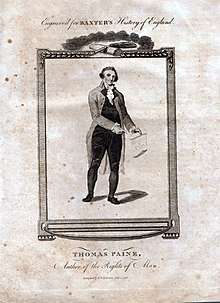
Back in London by 1787, Paine would become engrossed in the French Revolution after it began in 1789, and decided to travel to France in 1790. Meanwhile, conservative intellectual Edmund Burke launched a counterrevolutionary blast against the French Revolution, entitled Reflections on the Revolution in France (1790), which strongly appealed to the landed class, and sold 30,000 copies. Paine set out to refute it in his Rights of Man (1791). He wrote it not as a quick pamphlet, but as a long, abstract political tract of 90,000 words which tore apart monarchies and traditional social institutions. On January 31, 1791, he gave the manuscript to publisher Joseph Johnson. A visit by government agents dissuaded Johnson, so Paine gave the book to publisher J. S. Jordan, then went to Paris, per William Blake's advice. He charged three good friends, William Godwin, Thomas Brand Hollis, and Thomas Holcroft, with handling publication details. The book appeared on March 13, 1791 and sold nearly a million copies. It was "eagerly read by reformers, Protestant dissenters, democrats, London craftsmen, and the skilled factory-hands of the new industrial north".[64]

Undeterred by the government campaign to discredit him, Paine issued his Rights of Man, Part the Second, Combining Principle and Practice in February 1792. It detailed a representative government with enumerated social programs to remedy the numbing poverty of commoners through progressive tax measures. Radically reduced in price to ensure unprecedented circulation, it was sensational in its impact and gave birth to reform societies. An indictment for seditious libel followed, for both publisher and author, while government agents followed Paine and instigated mobs, hate meetings, and burnings in effigy. A fierce pamphlet war also resulted, in which Paine was defended and assailed in dozens of works.[65] The authorities aimed, with ultimate success, to chase Paine out of Great Britain. He was then tried in absentia and found guilty, although never executed. The French translation of Rights of Man, Part II was published in April 1792. The translator, François Lanthenas, eliminated the dedication to Lafayette, as he believed Paine thought too highly of Lafayette, who was seen as a royalist sympathizer at the time.[66]
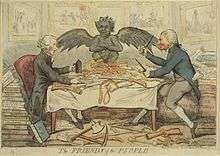
In summer of 1792, he answered the sedition and libel charges thus: "If, to expose the fraud and imposition of monarchy ... to promote universal peace, civilization, and commerce, and to break the chains of political superstition, and raise degraded man to his proper rank; if these things be libellous ... let the name of libeller be engraved on my tomb."[67]
Paine was an enthusiastic supporter of the French Revolution, and was granted honorary French citizenship alongside prominent contemporaries such as Alexander Hamilton, George Washington, Benjamin Franklin and others. Paine's honorary citizenship was in recognition of the publishing of his Rights of Man, Part II and the sensation it created within France.[68] Despite his inability to speak French, he was elected to the National Convention, representing the district of Pas-de-Calais.[69]
Several weeks after his election to the National Convention, Paine was selected as one of nine deputies to be part of the Convention's Constitutional Committee, who were charged to draft a suitable constitution for the French Republic.[70] He subsequentially participated in the Constitutional Committee in drafting the Girondin constitutional project. He voted for the French Republic, but argued against the execution of Louis XVI, saying the monarch should instead be exiled to the United States: firstly, because of the way royalist France had come to the aid of the American Revolution; and secondly, because of a moral objection to capital punishment in general and to revenge killings in particular. However, Paine's speech in defense of Louis XVI was interrupted by Jean-Paul Marat, who claimed that as a Quaker, Paine's religious beliefs ran counter to inflicting capital punishment and thus he should be ineligible to vote. Marat interrupted a second time, stating that the translator was deceiving the convention by distorting the meanings of Paine's words, prompting Paine to provide a copy of the speech as proof that he was being correctly translated.[71]
Regarded as an ally of the Girondins, he was seen with increasing disfavor by the Montagnards, who were now in power; and in particular by Maximilien Robespierre. A decree was passed at the end of 1793 excluding foreigners from their places in the Convention (Anacharsis Cloots was also deprived of his place). Paine was arrested and imprisoned in December 1793.[72]
Paine wrote the second part of Rights of Man on a desk in Thomas 'Clio' Rickman's house, with whom he was staying in 1792 before he fled to France. This desk is currently on display in the People's History Museum in Manchester.[73]
The Age of Reason

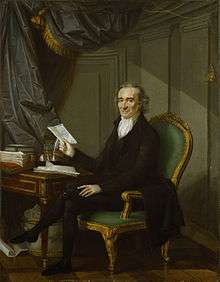
Paine was arrested in France on December 28, 1793. Joel Barlow was unsuccessful in securing Paine's release by circulating a petition among American residents in Paris.[74] Sixteen American citizens were allowed to plead for Paine's release to the Convention, yet President Marc-Guillaume Alexis Vadier of the Committee of General Security refused to acknowledge Paine's American citizenship, stating he was an Englishman and a citizen of a country at war with France.[75]
Paine himself protested and claimed that he was a citizen of the U.S., which was an ally of Revolutionary France, rather than of Great Britain, which was by that time at war with France. However, Gouverneur Morris, the American minister to France, did not press his claim, and Paine later wrote that Morris had connived at his imprisonment. Paine narrowly escaped execution. A chalk mark was supposed to be left by the gaoler on the door of a cell to denote that the prisoner inside was due to be removed for execution. In Paine's case, the mark had accidentally been made on the inside of his door rather than the outside; this was due to the fact that the door of Paine's cell had been left open whilst the gaoler was making his rounds that day, since Paine had been receiving official visitors. But for this quirk of fate, Paine would have been executed the following morning. He kept his head and survived the few vital days needed to be spared by the fall of Robespierre on 9 Thermidor (July 27, 1794).[76]
Paine was released in November 1794 largely because of the work of the new American Minister to France, James Monroe,[77] who successfully argued the case for Paine's American citizenship.[78] In July 1795, he was re-admitted into the Convention, as were other surviving Girondins. Paine was one of only three députés to oppose the adoption of the new 1795 constitution because it eliminated universal suffrage, which had been proclaimed by the Montagnard Constitution of 1793.[79]
In 1796, a bridge he designed was erected over the mouth of the Wear River at Sunderland, Tyne and Wear, England.[80] This bridge, the Sunderland arch, was after the same design as his Schuylkill River Bridge in Philadelphia and it became the prototype for many subsequent voussoir arches made in iron and steel.[81][82]
In addition to receiving a British patent for the single-span iron bridge, Paine developed a smokeless candle[83] and worked with inventor John Fitch in developing steam engines.
In 1797, Paine lived in Paris with Nicholas Bonneville and his wife. As well as Bonneville's other controversial guests, Paine aroused the suspicions of authorities. Bonneville hid the Royalist Antoine Joseph Barruel-Beauvert at his home. Beauvert had been outlawed following the coup of 18 Fructidor on September 4, 1797. Paine believed that the United States under President John Adams had betrayed revolutionary France.[84] Bonneville was then briefly jailed and his presses were confiscated, which meant financial ruin.
In 1800, still under police surveillance, Bonneville took refuge with his father in Evreux. Paine stayed on with him, helping Bonneville with the burden of translating the "Covenant Sea". The same year, Paine purportedly had a meeting with Napoleon. Napoleon claimed he slept with a copy of Rights of Man under his pillow and went so far as to say to Paine that "a statue of gold should be erected to you in every city in the universe".[85] Paine discussed with Napoleon how best to invade England. In December 1797, he wrote two essays, one of which was pointedly named Observations on the Construction and Operation of Navies with a Plan for an Invasion of England and the Final Overthrow of the English Government,[86] in which he promoted the idea to finance 1,000 gunboats to carry a French invading army across the English Channel. In 1804, Paine returned to the subject, writing To the People of England on the Invasion of England advocating the idea.[84] However, upon noting Napoleon's progress towards dictatorship, he condemned him as "the completest charlatan that ever existed".[87] Paine remained in France until 1802, returning to the United States only at President Jefferson's invitation.[88]
Criticism of George Washington
Upset that U.S. President George Washington, a lifelong friend, did nothing during Paine's imprisonment in France, Paine believed Washington had betrayed him and conspired with Robespierre. While staying with Monroe, Paine planned to send Washington a letter of grievance on the former President's birthday. Monroe stopped the letter from being sent, and after Paine's criticism of the Jay Treaty, which was supported by Washington, Monroe suggested that Paine live elsewhere.[89]
Paine then sent a stinging letter to George Washington, in which he described him as an incompetent commander and a vain and ungrateful person. Having received no response, Paine contacted his lifelong publisher Benjamin Bache, the Jeffersonian Democrat, to publish his Letter to George Washington of 1796 in which he derided Washington's reputation by describing him as a treacherous man who was unworthy of his fame as a military and political hero. Paine wrote that "the world will be puzzled to decide whether you are an apostate or an impostor; whether you have abandoned good principles or whether you ever had any".[90] He declared that without France's aid Washington could not have succeeded in the American Revolution and had "but little share in the glory of the final event". He also commented on Washington's character, saying that Washington had no sympathetic feelings and was a hypocrite.[91]
Later years
In 1802 or 1803, Paine left France for the United States, also paying the passage for Bonneville's wife Marguerite Brazier and the couple's three sons, Benjamin, Louis and Thomas Bonneville, to whom Paine was godfather. Paine returned to the United States in the early stages of the Second Great Awakening and a time of great political partisanship. The Age of Reason gave ample excuse for the religiously devout to dislike him and the Federalists attacked him for his ideas of government stated in Common Sense, for his association with the French Revolution and for his friendship with President Jefferson. Also still fresh in the minds of the public was his Letter to Washington published six years before his return. This was compounded when his right to vote was denied in New Rochelle on the grounds that Gouverneur Morris did not recognize him as an American and Washington had not aided him.[92]
Brazier took care of Paine at the end of his life and buried him after his death on June 8, 1809. In his will, Paine left the bulk of his estate to Marguerite, including 100 acres (40.5 ha) of his farm so she could maintain and educate Benjamin and his brother Thomas. In 1814, the fall of Napoleon finally allowed Bonneville to rejoin his wife in the United States where he remained for four years before returning to Paris to open a bookshop.
Death
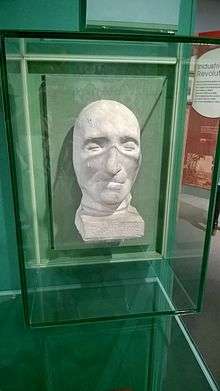
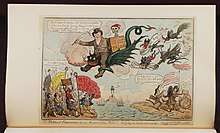
On the morning of June 8, 1809, Paine died, aged 72, at 59 Grove Street in Greenwich Village, New York City[93] Although the original building is no longer there, the present building has a plaque noting that Paine died at this location.[94]
After his death, Paine's body was brought to New Rochelle, but the Quakers would not allow it to be buried in their graveyard as per his last will, so his remains were buried under a walnut tree on his farm. In 1819, English agrarian radical journalist William Cobbett, who in 1793 had published a hostile continuation[95] of Francis Oldys (George Chalmer)'s The Life of Thomas Paine,[96] dug up his bones and transported them back to England with the intention to give Paine a heroic reburial on his native soil, but this never came to pass. The bones were still among Cobbett's effects when he died over fifteen years later, but were later lost. There is no confirmed story about what happened to them after that, although various people have claimed throughout the years to own parts of Paine's remains, such as his skull and right hand.[97][98][99]
At the time of his death, most American newspapers reprinted the obituary notice from the New York Evening Post that was in turn quoting from The American Citizen,[100] which read in part: "He had lived long, did some good, and much harm". Only six mourners came to his funeral, two of whom were black, most likely freedmen. Many years later the writer and orator Robert G. Ingersoll wrote:
Thomas Paine had passed the legendary limit of life. One by one most of his old friends and acquaintances had deserted him. Maligned on every side, execrated, shunned and abhorred – his virtues denounced as vices – his services forgotten – his character blackened, he preserved the poise and balance of his soul. He was a victim of the people, but his convictions remained unshaken. He was still a soldier in the army of freedom, and still tried to enlighten and civilize those who were impatiently waiting for his death. Even those who loved their enemies hated him, their friend – the friend of the whole world – with all their hearts. On the 8th of June 1809, death came – Death, almost his only friend. At his funeral no pomp, no pageantry, no civic procession, no military display. In a carriage, a woman and her son who had lived on the bounty of the dead – on horseback, a Quaker, the humanity of whose heart dominated the creed of his head – and, following on foot, two negroes filled with gratitude – constituted the funeral cortege of Thomas Paine.[101]
Ideas
Biographer Eric Foner identifies a utopian thread in Paine's thought, writing: "Through this new language he communicated a new vision—a utopian image of an egalitarian, republican society".[102]
Paine's utopianism combined civic republicanism, belief in the inevitability of scientific and social progress and commitment to free markets and liberty generally. The multiple sources of Paine's political theory all pointed to a society based on the common good and individualism. Paine expressed a redemptive futurism or political messianism.[103] Writing that his generation "would appear to the future as the Adam of a new world", Paine exemplified British utopianism.[104]
Later, his encounters with the Indigenous peoples of the Americas made a deep impression. The ability of the Iroquois to live in harmony with nature while achieving a democratic decision-making process helped him refine his thinking on how to organize society.[105]
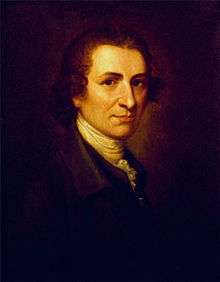
Slavery
On March 8, 1775, one month after Paine became the editor of The Pennsylvania Magazine, the magazine published an anonymous article titled "African Slavery in America," the first prominent piece in the colonies proposing the emancipation of African-American slaves and the abolition of slavery.[106]
Paine is often credited with writing the piece,[106] on the basis of later testimony by Benjamin Rush, cosigner of the Declaration of Independence.[26] Citing a lack of further evidence of Paine's authorship, however, scholars Foner and Alfred Owen Aldridge no longer consider it to be one of his works. By contrast, journalist John Nichols writes that Paine's "fervent objections to slavery" led to his exclusion from power during the early years of the Republic.[107]
State funded social programs
In his Rights of Man, Part Second, Paine advocated a comprehensive program of state support for the population to ensure the welfare of society, including state subsidy for poor people, state-financed universal public education, and state-sponsored prenatal care and postnatal care, including state subsidies to families at childbirth. Recognizing that a person's "labor ought to be over" before old age, Paine also called for a state pension to all workers starting at age 50, which would be doubled at age 60.[108]
Agrarian Justice
His last pamphlet, Agrarian Justice, published in the winter of 1795, opposed to agrarian law and to agrarian monopoly and further developed his ideas in the Rights of Man about how land ownership separated the majority of people from their rightful, natural inheritance and means of independent survival. The U.S. Social Security Administration recognizes Agrarian Justice as the first American proposal for an old-age pension and basic income or citizen's dividend. Per Agrarian Justice:
In advocating the case of the persons thus dispossessed, it is a right, and not a charity ... [Government must] create a national fund, out of which there shall be paid to every person, when arrived at the age of twenty-one years, the sum of fifteen pounds sterling, as a compensation in part, for the loss of his or her natural inheritance, by the introduction of the system of landed property. And also, the sum of ten pounds per annum, during life, to every person now living, of the age of fifty years, and to all others as they shall arrive at that age.
In 2011, £10 and £15 would be worth about £800 and £1,200 ($1,200 and $2,000) when adjusted for inflation.[109]
Lamb argues that Paine's analysis of property rights marks a distinct contribution to political theory. His theory of property defends a libertarian concern with private ownership that shows an egalitarian commitment. Paine's new justification of property sets him apart from previous theorists such as Hugo Grotius, Samuel von Pufendorf and John Locke. It demonstrates Paine's commitment to foundational liberal values of individual freedom and moral equality.[110]
Religious views
Before his arrest and imprisonment in France, knowing that he would probably be arrested and executed, following in the tradition of early eighteenth-century British deism Paine wrote the first part of The Age of Reason, an assault on organized "revealed" religion combining a compilation of the many inconsistencies he found in the Bible.
About his own religious beliefs, Paine wrote in The Age of Reason:
I believe in one God, and no more; and I hope for happiness beyond this life.
I do not believe in the creed professed by the Jewish church, by the Roman church, by the Greek church, by the Turkish church, by the Protestant church, nor by any church that I know of. My own mind is my own church. All national institutions of churches, whether Jewish, Christian or Turkish, appear to me no other than human inventions, set up to terrify and enslave mankind, and monopolize power and profit.
Whenever we read the obscene stories, the voluptuous debaucheries, the cruel and tortuous executions, the unrelenting vindictiveness with which more than half the Bible is filled, it would be more consistent that we call it the word of a demon than the word of God. It is a history of wickedness that has served to corrupt and brutalize mankind; and, for my part, I sincerely detest it, as I detest everything that is cruel.[111]
Though there is no evidence Paine himself was a Freemason,[112] upon his return to America from France he also penned "An Essay on the Origin of Free-Masonry" (1803–1805) about Freemasonry being derived from the religion of the ancient Druids.[113] In the essay, he stated: "The Christian religion is a parody on the worship of the sun, in which they put a man called Christ in the place of the sun, and pay him the adoration originally paid to the sun". Marguerite de Bonneville published the essay in 1810 after Paine's death, but she chose to omit certain passages from it that were critical of Christianity, most of which were restored in an 1818 printing.[114]
While Paine never described himself as a deist,[114] he did write the following:
The opinions I have advanced ... are the effect of the most clear and long-established conviction that the Bible and the Testament are impositions upon the world, that the fall of man, the account of Jesus Christ being the Son of God, and of his dying to appease the wrath of God, and of salvation, by that strange means, are all fabulous inventions, dishonorable to the wisdom and power of the Almighty; that the only true religion is Deism, by which I then meant, and mean now, the belief of one God, and an imitation of his moral character, or the practice of what are called moral virtues – and that it was upon this only (so far as religion is concerned) that I rested all my hopes of happiness hereafter. So say I now – and so help me God.[59]
Legacy
Historian Jack P. Greene stated:
- In a fundamental sense, we are today all Paine's children. It was not the British defeat at Yorktown, But Paine and the new American conception of political society he did so much to popularize in Europe that turned the world upside down.[115]
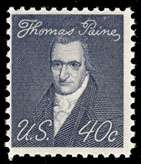
Harvey J. Kaye wrote that through Paine, through his pamphlets and catchphrases such as "The sun never shined on a cause of greater worth," "We have it in our power to begin the world over again," and "These are the times that try men's souls" did more than move Americans to declare their independence:
- he also imbued the nation they were founding with democratic impulse and aspiration and exceptional – indeed, world-historic – purpose and promise. For 230 years Americans have drawn ideas, inspiration, and encouragement from Paine and his work.[116]
John Stevenson argues that in the early 1790s, numerous radical political societies were formed throughout England and Wales in which Paine's writings provided "a boost to the self-confidence of those seeking to participate in politics for the first time."[117] In its immediate effects, Gary Kates argues, "Paine's vision unified Philadelphia merchants, British artisans, French peasants, Dutch reformers, and radical intellectuals from Boston to Berlin in one great movement."[118]
His writings in the long term inspired philosophic and working-class radicals in Britain and United States. Liberals, libertarians, left-libertarians, feminists, democratic socialists, social democrats, anarchists, free thinkers and progressives often claim him as an intellectual ancestor. Paine's critique of institutionalized religion and advocacy of rational thinking influenced many British freethinkers in the 19th and 20th centuries, such as William Cobbett, George Holyoake, Charles Bradlaugh, Christopher Hitchens and Bertrand Russell.[119]
The quote "Lead, follow, or get out of the way" is widely but incorrectly attributed to Paine. It can be found nowhere in his published works.[120]
Abraham Lincoln
In 1835, when Abraham Lincoln was 26 years old, he wrote a defense of Paine's deism.[121] A political associate, Samuel Hill, burned the manuscript to save Lincoln's political career.[122] Historian Roy Basler, the editor of Lincoln's papers, said Paine had a strong influence on Lincoln's style:
No other writer of the eighteenth century, with the exception of Jefferson, parallels more closely the temper or gist of Lincoln's later thought. In style, Paine above all others affords the variety of eloquence which, chastened and adapted to Lincoln's own mood, is revealed in Lincoln's formal writings.[123]
Thomas Edison
The inventor Thomas Edison said:
I have always regarded Paine as one of the greatest of all Americans. Never have we had a sounder intelligence in this republic.... It was my good fortune to encounter Thomas Paine's works in my boyhood... it was, indeed, a revelation to me to read that great thinker's views on political and theological subjects. Paine educated me, then, about many matters of which I had never before thought. I remember, very vividly, the flash of enlightenment that shone from Paine's writings, and I recall thinking, at that time, 'What a pity these works are not today the schoolbooks for all children!' My interest in Paine was not satisfied by my first reading of his works. I went back to them time and again, just as I have done since my boyhood days.[124]
South America
In 1811, Venezuelan translator Manuel Garcia de Sena published a book in Philadelphia that consisted mostly of Spanish translations of several of Paine's most important works.[125] The book also included translations of the Declaration of Independence, the Articles of Confederation, the U.S. Constitution and the constitutions of five U.S. states.[125]
It subsequently circulated widely in South America and through it Uruguayan national hero José Gervasio Artigas became familiar with and embraced Paine's ideas. In turn, many of Artigas's writings drew directly from Paine's, including the Instructions of 1813, which Uruguayans consider to be one of their country's most important constitutional documents, was one of the earliest writings to articulate a principled basis for an identity independent of Buenos Aires.[125]
Memorials
The first and longest-standing memorial to Paine is the carved and inscribed 12-foot marble column in New Rochelle, New York, organized and funded by publisher, educator and reformer Gilbert Vale (1791–1866) and raised in 1839 by the American sculptor and architect John Frazee, the Thomas Paine Monument (see image below).[126]
New Rochelle is also the original site of Thomas Paine's Cottage, which along with a 320-acre (130 ha) farm were presented to Paine in 1784 by act of the New York State Legislature for his services in the American Revolution.[127]
The same site is the home of the Thomas Paine Memorial Museum. Thomas Edison helped to turn the first shovel of earth for the museum which serves as a museum to display both Paine relics as well as others of local historical interest. A large collection of books, pamphlets, and pictures is contained in the Paine library, including many first editions of Paine's works as well as several original manuscripts. The holdings, the subject of a sell-off controversy, were temporarily relocated to the New-York Historical Society and have since been more permanently archived in the Iona College library nearby.[128]
Paine was originally buried near the current location of his house and monument upon his death in 1809. The site is marked by a small headstone and burial plaque even though his remains were removed years later.[94]
In the 20th century, Joseph Lewis, longtime president of the Freethinkers of America and an ardent Paine admirer, was instrumental in having larger-than-life-sized statues of Paine erected in each of the three countries with which the revolutionary writer was associated. The first, created by Mount Rushmore sculptor Gutzon Borglum, was erected in Paris just before World War II began but not formally dedicated until 1948. It depicts Paine standing before the French National Convention to plead for the life of King Louis XVI. The second, sculpted in 1950 by Georg J. Lober, was erected near Paine's one time home in Morristown, New Jersey. It shows a seated Paine using a drum-head as a makeshift table. The third, sculpted by Sir Charles Wheeler, President of the Royal Academy, was erected in 1964 in Paine's birthplace, Thetford, England. With quill pen in his right hand and an inverted copy of The Rights of Man in his left, it occupies a prominent spot on King Street. Thomas Paine was ranked No. 34 in the 100 Greatest Britons 2002 extensive Nationwide poll conducted by the BBC.[129]
A bronze plaque attached to the wall of Thetford's Thomas Paine Hotel gives details of Paine's life.[130] It was placed there in 1943 by voluntary contributions from U.S. airmen from a nearby bomber base. Texas folklorist and freethinker J. Frank Dobie, then teaching at Cambridge University, participated in the dedication ceremonies.[131]
In New York City, the Thomas Paine Park is marked by a fountain called The Triumph of the Human Spirit. Located in downtown Manhattan, near City Hall, the 300-ton-plus monument was dedicated on October 12, 2000.[132]
Bronx Community College includes Paine in its Hall of Fame of Great Americans and there are statues of Paine in Morristown and Bordentown, New Jersey and in the Parc Montsouris, in Paris.[133][134]
In Paris, there is a plaque in the street where he lived from 1797 to 1802 that says: "Thomas PAINE / 1737–1809 / Englishman by birth / American by adoption / French by decree".
Yearly, between July 4 and 14, the Lewes Town Council in the United Kingdom celebrates the life and work of Paine.[135]
In the early 1990s, largely through the efforts of citizen activist David Henley of Virginia, legislation (S.Con.Res 110 and H.R. 1628) was introduced in the 102nd Congress by ideological opposites Sen. Steve Symms (R-ID) and Rep. Nita Lowey (D-NY). With over 100 formal letters of endorsement by United States and foreign historians, philosophers and organizations, including the Thomas Paine National Historical Society, the legislation garnered 78 original co-sponsors in the Senate and 230 original co-sponsors in the House of Representatives, and was consequently passed by both houses' unanimous consent. In October 1992, the legislation was signed into law (PL102-407 and PL102-459) by President George H. W. Bush authorizing the construction by using private funds of a memorial to Thomas Paine in "Area 1" of the grounds of the U.S. Capitol. As of January 2011, the memorial has not yet been built.
The University of East Anglia's Norwich Business School is housed in the Thomas Paine Study Centre on its Norwich campus in Paine's home county of Norfolk.[136]
The Cookes House is reputed to have been his home during the Second Continental Congress at York, Pennsylvania.[137]
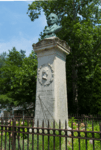 John Frazee's Thomas Paine Monument in New Rochelle
John Frazee's Thomas Paine Monument in New Rochelle- Statue in Bordentown, New Jersey
 Plaque honoring Paine at 10 rue de l'Odéon, Paris
Plaque honoring Paine at 10 rue de l'Odéon, Paris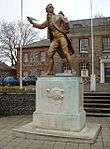 Statue in Thetford, Norfolk, England, Paine's birthplace
Statue in Thetford, Norfolk, England, Paine's birthplace Plaque on Thomas Paine Hotel, Thetford
Plaque on Thomas Paine Hotel, Thetford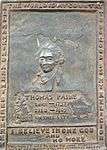 Commemorative plaque on the site of the former residence of Paine in Greenwich Village, New York City
Commemorative plaque on the site of the former residence of Paine in Greenwich Village, New York City
In popular culture
- The 1982 French-Italian film That Night in Varennes is about a fictional meeting of Casanova, Chevalier de Seingalt (played by Italian actor Marcello Mastroianni), Nicolas Edmé Restif de la Bretonne, Countess Sophie de la Borde and Thomas Paine (played by American actor Harvey Keitel) as they ride in a carriage a few hours behind the carriage carrying the King and Queen of France, Louis XVI and Marie Antoinette, on their attempt to escape from revolutionary France in 1791.
- In 1987, Paine's life was dramatized in Howard Fast's play "Citizen Tom Paine," with Richard Thomas in the title role, staged in Philadelphia and Washington, DC, in the bicentennial year of the United States Constitution. (Louise Sweeney (1987). "On stage: reliving historic turning points. Howard Fast's `Citizen Tom Paine'" "Christian Science Monitor." March 12, 1987.)
- Jack Shepherd's stage play In Lambeth dramatized a visit by Thomas Paine to the Lambeth home of William and Catherine Blake in 1789.
- In 1995, English folk singer Graham Moore, from Dorset, wrote "Tom Paine's Bones" which he recorded on his album of the same name.[138][139] In 2001, the Scottish musician Dick Gaughan included the song on his album Outlaws and Dreamers.
- In 2005, Trevor Griffiths published These are the Times: A Life of Thomas Paine, originally written as a screenplay for Richard Attenborough Productions. Although the film was not made, the play was broadcast as a two-part drama on BBC Radio 4 in 2008,[140] with a repeat in 2012.[141] In 2009, Griffiths adapted the screenplay for a production entitled A New World at Shakespeare's Globe theatre on London's South Bank.
- Harry Turtledove's 2008 alternate history novel The United States of Atlantis features Paine as a character.
- In 2009, Paine's life was dramatized in the play Thomas Paine Citizen of the World,[142] produced for the "Tom Paine 200 Celebrations" festival[143]
- Paine's role in the foundation of the United States is depicted in a pseudo-biographical fashion in the educational animated series Liberty's Kids produced by DIC Entertainment.
- Paine is a character in the Bob Dylan song "As I Went Out One Morning", featured on Dylan's 1968 album, John Wesley Harding.[144]
- A fictional version of Paine is featured in the Deborah Harkness book "Time's Convert".[145]
- Paine is featured in an essay celebrating the forgotten founding father in Mo Rocca's book "Mobituaries: Great Lives Worth Living," published by Simon & Schuster on November 5, 2019.
See also
- Asset-based egalitarianism
- British philosophy
- Contributions to liberal theory
- Liberty
- List of American philosophers
- List of British philosophers
- List of civil rights leaders
- Society of the Friends of Truth
Notes
- Conway, Moncure D. (1908). The Life of Thomas Paine. Volume 1. Cobbett, William, Illustrator. G. P. Putnam's Sons. p. 3. Retrieved October 2, 2013. – In the contemporary record as noted by Conway, Paine's birth date is given as January 29, 1736–37. Common practice was to use a dash or a slash to separate the old-style year from the new-style year. In the old calendar, the new year began on March 25, not January 1. Paine's birth date, therefore, would have been before New Year, 1737. In the new style, his birth date advances by eleven days and his year increases by one to February 9, 1737. The O.S. link gives more detail if needed.
- From Jack P. Green (1978) "Paine, America, and the "Modernization" of Political Consciousness", cited in Edward Larkin (2005) "Thomas Paine and the Literature of Revolution."
References
Citations
- Ayer, Alfred Jules (1990). Thomas Paine. University of Chicago Press. p. 1. ISBN 978-0-226-03339-6.
- Henretta, James A.; et al. (2011). America's History, Volume 1: To 1877. Macmillan. p. 165. ISBN 9780312387914.
- Jason D. Solinger. "Thomas Paine's Continental Mind". Early American Literature (2010) Vol. 45 Issue 3, pp. 593–617. doi:10.1353/eal.2010.0029. JSTOR 25800115.
- Saul K. Padover, Jefferson: A Great American's Life and Ideas, (1952), p. 32.
- Hitchens, Christopher (2008). Thomas Paine's Rights of Man. Grove Press. p. 37. ISBN 978-0-8021-4383-9.
- Biographer Harvey Kaye writes, "Within just a few months 150,000 copies of one or another edition were distributed in America alone. The equivalent sales today would be fifteen million, making it, proportionally, the nation's greatest best-seller ever." In Kaye, Harvey J. (2005). Thomas Paine And The Promise of America. Hill & Wang. p. 43. ISBN 978-0-8090-9344-1.
- "The Sharpened Quill", The New Yorker; accessed November 6, 2010.
- Conway, Moncure D. (1892). The Life of Thomas Paine. Vol. 2, pp. 417–18.
- "Paine, Thomas (1737–1809), author and revolutionary". Oxford Dictionary of National Biography. doi:10.1093/ref:odnb/9780198614128.001.0001 (inactive January 25, 2020).
- Crosby, Alan (1986). A History of Thetford (1st ed.). Chichester, Sussex: Phillimore & Co. pp. 44–84. ISBN 978-0-85033-604-7.
- "National Archives". UK National ArchivesAcknowledgement dated March 2, 1769, document NU/1/3/3 Cite journal requires
|journal=(help) - School History Archived December 5, 2010, at the Wayback Machine Thetford Grammar School; accessed January 3, 2008,
- Keane, John (1995). Tom Paine, A Political Life (First ed.). London: Bloomsbury. p. 30. ISBN 0-8021-3964-7.
- Bell, J.L. "The Evidence for Paine as a Staymaker". Boston 1775. Retrieved October 3, 2019.
- Keane, John (1995). Tom Paine, A Political Life (First ed.). London: Bloomsbury. p. 38. ISBN 0-8021-3964-7.
- "Thomas Paine". Sandwich People & History. Open Sandwich. Retrieved April 2, 2010.
- "Thomas Paine, 1737–1809". historyguide.org.
- Conway, Moncure Daniel (1892). "The Life of Thomas Paine: With a History of Literary, Political, and Religious Career in America, France, and England". Thomas Paine National Historical Association. p. 20, vol. I. Archived from the original on April 18, 2009. Retrieved July 18, 2009.
- Kaye, Harvey J. (2000). Thomas Paine: Firebrand of the Revolution. Oxford University Press. p. 36. ISBN 978-0195116274.
- Martin, David; Clubb, Jane (2009). "An Archaeological Interpretative Survey of BULL HOUSE, 92 HIGH STREET, LEWES, EAST SUSSEX" (PDF). Sussex Archaeological Society. Retrieved August 20, 2019.
- Rickman, Thomas Clio (18??). The Life of Thomas Paine, Author of "Common Sense," "Rights of Man," "Age of Reason," "Letters to the Addresser[!]," &c., &c. B.D. Cousins. Check date values in:
|date=(help) - "Letter to the Honorable Henry Laurens" in Philip S. Foner's The Complete Writings of Thomas Paine (New York: Citadel Press, 1945), 2:1160–65.
- "Thomas Paine | British-American author". Encyclopedia Britannica. Retrieved September 15, 2017.
- Conway, Moncure Daniel, 1892. The Life of Thomas Paine vol. 1, p. 209.
- Larkin, Edward (2005). Thomas Paine and the Literature of Revolution. Cambridge University Press. pp. 31–40. ISBN 9781139445986. Retrieved December 1, 2018.
- American Antislavery Writings: Colonial Beginnings to Emancipation. Library of America. 2012. ISBN 9781598532142. Retrieved December 1, 2018.
- Green, Jack (1978). "Paine, America, and the "Modernization" of Political Consciousness". Political Science Quarterly. 93 (1): 73–92. doi:10.2307/2149051. JSTOR 2149051.
- K. M. Kostyal. Funding Fathers: The Fight for Freedom and the Birth of American Liberty (2014) ch. 2
- David Braff, "Forgotten Founding Father: The Impact of Thomas Paine," in Joyce Chumbley, ed., Thomas Paine: In Search of the Common Good (2009).
- Oliphant, John. "Paine, Thomas". Encyclopedia of the American Revolution: Library of Military History. Retrieved April 10, 2007 – via Gale Virtual Library.
- Scharf, T. History of Philadelphia. Рипол Классик. p. 310. ISBN 9785883517104.
- Robert A. Ferguson (July 2000). "The Commonalities of Common Sense". William and Mary Quarterly. 57#3 (3): 465–504. JSTOR 2674263.
- Philp, Mark (2013). Edward N. Zalta (ed.). "Thomas Paine". Stanford Encyclopedia of Philosophy (Winter 2013 Edition). Retrieved January 24, 2015.
- Merrill Jensen, The Founding of a Nation: A History of the American Revolution, 1763–1776 (New York: Oxford University Press, 1968), 668.
- David C. Hoffman, "Paine and Prejudice: Rhetorical Leadership through Perceptual Framing in Common Sense." Rhetoric and Public Affairs, Fall 2006, Vol. 9, Issue 3, pp. 373–410.
- Pauline Maier, American Scripture: Making the Declaration of Independence (New York: Knopf, 1997), 90–91.
- Jack N. Rakove, The Beginnings of National Politics: An Interpretive History of the Continental Congress (New York: Knopf, 1979), 89.
- Jack S. Levy, William R. Thompson, Causes of War (John Wiley & Sons, 2011).
- New, M. Christopher. "James Chalmers and Plain Truth A Loyalist Answers Thomas Paine". Archiving Early America. Retrieved October 3, 2007.
- Jensen, Founding of a Nation, 669.
- "Adams Papers Digital Edition – Massachusetts Historical Society". www.masshist.org. Retrieved December 5, 2018.
- Rosenfeld, Sophia (2008). "Tom Paine's Common Sense and Ours". The William and Mary Quarterly. 65 (4): 633–668. JSTOR 40212021.
- Robert Middlekauff (2005), The Glorious Cause: The American Revolution, 1763–1789, Revised and Expanded Edition, Oxford University Press, New York, NY; ISBN 978-0-19-531588-2, pp. 30–53.
- Robert Middlekauff, The Glorious Cause, pp. 4–5, 324–26.
- Cf. Clifton E. Olmstead (1960), History of Religion in the United States, Prentice-Hall, Englewood Cliffs, NJ, pg. 178.
- Martin Roth, "Tom Paine and American Loneliness." Early American Literature, September 1987, Vol. 22, Issue 2, pp. 175–82.
- "Thomas Paine. The American Crisis. Philadelphia, Styner and Cist, 1776–77". Indiana University. Retrieved November 15, 2007.
- Nelson, Craig (2007). Thomas Paine: Enlightenment, Revolution, and the Birth of Modern Nations. Penguin. pp. 174–75. ISBN 9781101201787.
- Blakemore, Steve (1997). Crisis in representation: Thomas Paine, Mary Wollstonecraft, Helen Maria Williams, and the rewriting of the French Revolution. Fairleigh Dickinson University Press.
- Harlow Giles Unger, "Thomas Paine and the Clarion Call for American Independence," (New York: Da Capo Press, 2019), p. 89
- Harlow Giles Unger, "Thomas Paine and the Clarion Call for American Independence," (New York: Da Capo Press, 2019), p. 89
- Craig Nelson (2006). Thomas Paine. New York : Viking. pp. 134–38. ISBN 978-0-670-03788-9.
- Harlow Giles Unger, "Thomas Paine and the Clarion Call for American Independence," (New York: Da Capo Press, 2019), p. 93
- Harlow Giles Unger, "Thomas Paine and the Clarion Call for American Independence," (New York: Da Capo Press, 2019), p. 102-103
- Harlow Giles Unger, "Thomas Paine and the Clarion Call for American Independence," (New York: Da Capo Press, 2019), p. 100-101
- Daniel Wheeler's Life and Writings of Thomas Paine Vol. 1 (1908) pp. 26–27.
- Daniel Wheeler, Life and Writings of Thomas Paine Vol. 1 (1908), pg. 314.
- Paine, Thomas (2005). Common Sense and Other Writings. Barnes & Noble Classics. p. xiii. ISBN 978-0-672-60004-3.
- Thomas Paine (1824), The Theological Works of Thomas Paine, R. Carlile, p. 138
- Chaplin, Philippa J. (August 1, 2004). "Revolution Echoes Yet in Bordentown: The Place Patriot Thomas Paine Once Called Home Still Honors Him". Philadelphia Inquirer – via ProQuest.
- Aldridge, Alfred (1959). Man Of Reason: The Life Of Thomas Paine. Philadelphia: J. B. Lippincott Company. p. 109.
- Ziesche, Philipp (2013). Paine and Jefferson in the Age of Revolutions. University of Virginia Press. p. 124.
- Aldridge, Alfred (1959). Man Of Reason: The Life Of Thomas Paine. Philadelphia: J. B. Lippincott Company. pp. 120–21.
- George Rudé, Revolutionary Europe: 1783–1815 (1964), pg. 183.
- Many of these are reprinted in Political Writings of the 1790s, ed. G. Claeys (8 vols, London: Pickering and Chatto, 1995).
- Ziesche, Phillipp (2010). Cosmopolitan Patriots: Americans in Paris in the Age of Revolution. University of Virginia Press. p. 63.
- Thomas Paine, Letter Addressed To The Addressers On The Late Proclamation, in Michael Foot, Isaac Kramnick (ed.), The Thomas Paine Reader, pg. 374
- Ziesche, Philipp (2010). Cosmopolitan Patriots: Americans in Paris in the Age of Revolution. University of Virginia Press. p. 62.
- Fruchtman, Jack (2009). The Political Philosophy of Thomas Paine. Baltimore, MD: Johns Hopkins University Press. p. 192. ISBN 978-0-8018-9284-4.
- Munck, Thomas (2013). Paine and Jefferson in the Age of Revolutions. University of Virginia Press. p. 165.
- Hawke, David (1974). Paine. New York, NY: Harper & Row Publishers. pp. 275–76.
- Vikki Vickers (May 5, 2008). My Pen and My Soul Have Ever Gone Together: Thomas Paine and the American Revolution. Routledge. pp. 2–. ISBN 978-1-135-92157-6.
- Collection highlights, Tom Paine's Desk, People's History Museum
- Ziesche, Philipp (2010). Cosmopolitan Patriots: Americans in Paris in the Age of Revolution. University of Virginia Press. p. 86.
- Hawke, David (1974). Paine. New York, NY: Harper & Row Publishers. pp. 297–98.
- Paine, Thomas; Rickman, Thomas Clio (1908). "The Life and Writings of Thomas Paine: Containing a Biography". Vincent Parke & Co.: 261–62. Retrieved February 21, 2008.
thomas paine jailer door.
Cite journal requires|journal=(help) - Foot, Michael, and Kramnick, Isaac. 1987. The Thomas Paine Reader, p. 16
- Eric Foner, 1976. Tom Paine and Revolutionary America, pg. 244.
- Aulard, Alphonse. 1901. Histoire politique de la Révolution française, pg. 555.
- Yorkshire Stingo
- History of Bridge Engineering, H.G. Tyrrell, Chicago, 1911.
- A biographical Dictionary of Civil Engineers in Great Britain and Ireland at 753–55, A. W. Skempton and M. Chrimes, ed., Thomas Telford, 2002; (ISBN 0-7277-2939-X, ISBN 978-0727729392)
- See Thomas Paine Archived September 29, 2006, at the Wayback Machine, Independence Hall Association; accessed online November 4, 2006.
- "Mark Philp, 'Paine, Thomas (1737–1809)', Oxford Dictionary of National Biography, Oxford University Press, September 2004; online edn, May 2008, accessed July 26, 2008". 2004. doi:10.1093/ref:odnb/21133. Cite journal requires
|journal=(help) - O'Neill, Brendan (June 8, 2009). "Who was Thomas Paine?". BBC. Retrieved June 10, 2018.
- Papers of James Monroe ... from the original manuscripts in the Library of Congress. Washington : Government Printing Office. 1904.
- Craig Nelson (2006). Thomas Paine. New York : Viking. p. 299. ISBN 978-0-670-03788-9.
- "Founders Online: From Thomas Jefferson to Thomas Paine, 18 March 1801". founders.archives.gov. Retrieved August 20, 2019.
- Craig Nelson (2006). Thomas Paine. New York : Viking. p. 291. ISBN 978-0-670-03788-9.
- Paine, Thomas. "Letter to George Washington, July 30, 1796: "On Paine's Service to America"". Archived from the original on September 27, 2006. Retrieved November 4, 2006.
- Craig Nelson (2006). Thomas Paine. New York : Viking. pp. 292–94. ISBN 978-0-670-03788-9.
- Claeys, Gregory, 1989. Thomas Paine, Social and Political Thought.
- "Thomas Paine". ushistory.org. Retrieved September 15, 2017.
- Walsh, Kevin (May 1999). "A PAINE IN THE VILLAGE – Forgotten New York". Retrieved March 12, 2019.
- William Cobbett, The Life of Thomas Paine, Interspersed with Remarks and Reflections (London: J. Wright, 1797)
- "Francis Oldys" [George Chalmers], The Life of Thomas Paine. One Penny-Worth of Truth, from Thomas Bull to His Brother John (London: Stockdale, 1791)
- "The Paine Monument at Last Finds a Home". The New York Times. October 15, 1905. Retrieved February 23, 2008.
- Chen, David W. "Rehabilitating Thomas Paine, Bit by Bony Bit". The New York Times. Retrieved February 23, 2008.
- Burrows, Edwin G. and Wallace, Mike. Gotham: A History of New York City to 1898. New York: Oxford University Press, 1999, pg. 510.
- "Paine's Obituary (click the "1809" link; it is 1/3 way down the 4th column)". New York Evening Post. June 10, 1809. Retrieved November 22, 2013.
- Robert G. Ingersoll (1892). Thomas Paine (1892). Thomas Paine National Historical Association. Retrieved December 3, 2017.
- Eric Foner (2005). Tom Paine and Revolutionary America. Oxford University Press, 2nd edition. pp. xxxii, 16. ISBN 9780195174861.
- Mark Jendrysik, "Tom Paine: Utopian?", Utopian Studies (2007) 18#2 pp. 139–57.
- Gregory Claeys, ed. (2010). The Cambridge Companion to Utopian Literature. Cambridge University Press. pp. 11–12. ISBN 9781139828420.CS1 maint: extra text: authors list (link)
- Weatherford, Jack "Indian Givers How the Indians of the Americas Transformed the World", 1988, p. 125.
- Rodriguez, Junius P. (2007). Slavery in the United States: A Social, Political, and Historical Encyclopedia. ABC-CLIO. p. 279. ISBN 9781851095445.
- Nichols, John (January 20, 2009). "Obama's Vindication of Thomas Paine". The Nation.
- Harlow Giles Under, "Thomas Paine and the Clarion Call for American Independence" (New York: Da Capo Press, 2019), p. 154
- "Purchasing Power of British Pounds from 1264 to Present". Measuringworth.com. February 15, 1971. Retrieved December 26, 2011.
- Lamb, Robert. "Liberty, Equality, and the Boundaries of Ownership: Thomas Paine's Theory of Property Rights." Review of Politics (2010), 72#3, pp. 483–511.
- Thomas Paine; et al. (1824). The Theological Works of Thomas Paine. R. Carlile. p. 31.
- Shai Afsai (Fall 2010). "Thomas Paine's Masonic Essay and the Question of His Membership in the Fraternity" (PDF). Philalethes 63 (4): 138–44. Retrieved March 5, 2011.
As he was certainly not a Master Mason when he wrote the essay—and as there is no evidence he joined the fraternity after then—one may conclude, as have Mackey, Newton, and others, that Paine was not a Freemason. Still, though the 'pantheon of Masons' may not hold Thomas Paine, this influential and controversial man remains connected to Freemasonry, if only due to the close friendships he had with some in the fraternity, and to his having written an intriguing essay on its origins.
- Shai Afsai, "Thomas Paine's Masonic Essay and the Question of His Membership in the Fraternity." Philalethes 63:4 (Fall 2010), pp. 140–41.
- Afsai, Shai (2012). "Thomas Paine, Freemason or Deist?". Early America Review (Winter/Spring).
- Jack P. Greene, "Paine, America, and the 'Modernization' Of Political Consciousness," Political Science Quarterly 93#1 (1978) pp 73–92, quoting page 92 Online.
- Harvey J. Kaye (2007). Thomas Paine and the Promise of America: A History & Biography. Farrar, Straus and Giroux. p. 258. ISBN 9780374707064.
- John Stevenson, "'Paineites to a Man'? The English Popular Radical Societies in the 1790s," Bulletin – Society for the Study of Labour History (1989) 54#1 pp 14–25.
- Gary Kates. "From Liberalism to Radicalism " (1989) p 569.
- Gary Kates, 'From liberalism to radicalism: Tom Paine's Rights of Man" Journal of the History of Ideas (1989) 50#4 pp 569–587.
- Gray, Rosie (February 1, 2012). "Mitt Romney Misquoted Thomas Paine In Victory Speech". BuzzFeed News. Retrieved April 26, 2019.
- Robert Havlik, "Some Influences of Thomas Paine's Age of Reason Upon Abraham Lincoln," Lincoln Herald, 104 (Summer 2002): 61–70.
- Michael Burlingame, Abraham Lincoln: a life (2008), vol. 2, p. 83.
- Roy P. Basler (ed.), Abraham Lincoln: His Speeches and Writings (1946), p. 6.
- Thomas Edison, Introduction to The Life and Works of Thomas Paine, New York: Citadel Press, 1945, Vol. I, pp. vii–ix. Reproduced online on thomaspaine.org, accessed November 4, 2006.
- John Street, Artigas and the Emancipation of Uruguay (London: Cambridge University Press, 1959), 178–86.
- See Frederick S. Voss, John Frazee 1790–1852 Sculptor (Washington City and Boston: The National Portrait Gallery and The Boston Athenaeum, 1986), pp. 46–47.
- See Alfred Owen Aldridge, Man of Reason (Philadelphia: J. P. Lippincott Company, 1959), pg. 103.
- "Academics: Libraries". Iona College. Archived from the original on May 29, 2013.
- "BBC – 100 Great British Heroes". BBC News. August 21, 2002. Retrieved December 26, 2011.
- "About the hotel".
- J. Frank Dobie, A Texan in England. Austin, Texas: University of Texas Press, 1980, pp. 84–85.
- "Thomas Paine Park Monuments – Triumph of the Human Spirit : NYC Parks".
- "Photos of Tom Paine and Some of His Writings". Morristown.org. Archived from the original on September 28, 2007. Retrieved January 10, 2008.
- "Parc Montsouris". Paris Walking Tours. Retrieved January 10, 2008.
- The Tom Paine Project Archived October 9, 2006, at the Wayback Machine, Lewes Town Council; retrieved November 4, 2006.
- "Thomas Paine Study Centre – University of East Anglia (UEA)". uea.ac.uk. Retrieved December 7, 2011.
- "National Historic Landmarks & National Register of Historic Places in Pennsylvania" (Searchable database). CRGIS: Cultural Resources Geographic Information System. Note: This includes Register, Pennsylvania (March 1972). "National Register of Historic Places Inventory Nomination Form: Cookes House" (PDF). Archived from the original (PDF) on March 14, 2012. Retrieved December 18, 2011.
- Graham Moore. "Heart of Darkness". Archived from the original on February 2, 2016.
- "Graham Moore blogspot".
- "BBC Radio 4 – Saturday Drama – Episodes by". Bbc.co.uk. August 2008. Retrieved May 7, 2014.
- "BBC Radio 4 – Saturday Drama – Episodes by". Bbc.co.uk. August 2012. Retrieved May 7, 2014.
- "Thomas Paine – "Citizen Of The World"". Keystage-company.co.uk. Retrieved May 7, 2014.
- Tom Paine Legacy Archived January 17, 2012, at the Wayback Machine, Programme for bicentenary celebrations in Thetford, the town of his birth.
- TonyAttwood. "As I went out one morning: Dylan paints an abstract revolution". Untold Dylan. Retrieved February 1, 2019.
- Harkness, Deborah (2018). Times Convert. Viking. ISBN 9780399564512.
Sources
- Aldridge, A. Owen (1959). Man of Reason: The Life of Thomas Paine. Lippincott.CS1 maint: ref=harv (link). Regarded by British authorities as the standard biography.
- Aldridge, A. Owen (1984). Thomas Paine's American Ideology. University of Delaware Press. ISBN 9780874132601.CS1 maint: ref=harv (link)
- Ayer, A. J. (1988). Thomas Paine. University of Chicago Press.CS1 maint: ref=harv (link)
- Bailyn, Bernard (1990). Bailyn (ed.). Common Sense. Faces of Revolution: Personalities and Themes in the Struggle for American Independence. Alfred A. Knopf.CS1 maint: ref=harv (link)
- Bernstein, R. B. (1994). "Review Essay: Rediscovering Thomas Paine". New York Law School Law Review.CS1 maint: ref=harv (link). Valuable blend of historiographical essay and biographical/analytical treatment.
- Butler, Marilyn (1984). Burke Paine and Godwin and the Revolution Controversy.CS1 maint: ref=harv (link)
- Claeys, Gregory (1989). Thomas Paine, Social and Political Thought. London: Unwin Hyman. ISBN 9780203193204.CS1 maint: ref=harv (link). Excellent analysis of Paine's thought.
- Conway, Moncure Daniel (1892). The Life of Thomas Paine. G.P. Putnam's Sons.CS1 maint: ref=harv (link). Long hailed as the definitive biography, and still valuable.
- Ferguson, Robert A. (July 2000). "The Commonalities of Common Sense". William and Mary Quarterly. 57#3 (3): 465–504. JSTOR 2674263.
- Foner, Eric (1976). Tom Paine and Revolutionary America. Oxford University Press.CS1 maint: ref=harv (link). The standard monograph treating Paine's thought and work with regard to America.
- Foner, Eric (2000). Thomas Paine. American National Biography Online.CS1 maint: ref=harv (link)
- Greene, Jack P. "Paine, America, and the 'Modernization' Of Political Consciousness," Political Science Quarterly 93#1 (1978) pp 73–92 Online.
- Griffiths, Trevor (2005). These Are the Times: A Life of Thomas Paine. Spokesman Books.CS1 maint: ref=harv (link)
- Hawke, David Freeman (1974). Paine. Philadelphia.CS1 maint: ref=harv (link) Regarded by many American authorities as the standard biography.
- Hitchens, Christopher (2007). Thomas Paine's "Rights of Man": A Biography. London: Atlantic Books. ISBN 978-1843546283.CS1 maint: ref=harv (link)
- Kates, Gary (1989). "From Liberalism to Radicalism: Tom Paine's Rights of Man". Journal of the History of Ideas. 50 (4): 569–587. doi:10.2307/2709798. JSTOR 2709798.
- Kaye, Harvey J. (2005). Thomas Paine and the Promise of America. Hill and Wang.CS1 maint: ref=harv (link)
- Keane, John (1995). Tom Paine: A Political Life. London: Bloomsbury.CS1 maint: ref=harv (link). One of the most valuable recent studies.
- Lamb, Robert (2010). "Liberty, Equality, and the Boundaries of Ownership: Thomas Paine's Theory of Property Rights". Review of Politics. 72 (3).
- Larkin, Edward (2005). Thomas Paine and the Literature of Revolution. Cambridge University Press.CS1 maint: ref=harv (link)
- Lessay, Jean (1987). L'américain de la Convention, Thomas Paine: Professeur de révolutions [The National Convention's American, Thomas Paine, professor of revolution] (in French). Paris: Éditions Perrin. p. 241.CS1 maint: ref=harv (link)
- Levin, Yuval (2013). The Great Debate: Edmund Burke, Thomas Paine, and the Birth of Right and Left. Basic Books. ISBN 978-0465062980.CS1 maint: ref=harv (link). Their debate over the French Revolution.
- Lewis, Joseph L. (1947). Thomas Paine: The Author of the Declaration of Independence. New York: Freethought Press Association.CS1 maint: ref=harv (link)
- Nelson, Craig (2006). Thomas Paine: Enlightenment, Revolution, and the Birth of Modern Nations. Viking. ISBN 978-0-670-03788-9.CS1 maint: ref=harv (link)
- Phillips, Mark (May 2008). "Paine, Thomas (1737–1809)". Oxford Dictionary of National Biography (online ed.). Oxford University Press. doi:10.1093/ref:odnb/21133.CS1 maint: ref=harv (link) (Subscription or UK public library membership required.)
- Powell, David (1985). Tom Paine, The Greatest Exile. Hutchinson.CS1 maint: ref=harv (link)
- Russell, Bertrand (1934). "The Fate of Thomas Paine". Cite journal requires
|journal=(help)CS1 maint: ref=harv (link) - Solinger, Jason D. (November 2010). "Thomas Paine's Continental Mind". Early American Literature. 45 (3).
- Vincent, Bernard (2005). The Transatlantic Republican: Thomas Paine and the age of revolutions. ISBN 978-9042016149.CS1 maint: ref=harv (link)
- Wilensky, Mark (2008). The Elementary Common Sense of Thomas Paine. An Interactive Adaptation for All Ages. Casemate. ISBN 978-1-932714-36-4.CS1 maint: ref=harv (link)
- Washburne, E. B. (May 1880). "Thomas Paine and the French Revolution". Scribner's Monthly. XX.CS1 maint: ref=harv (link)
Fiction
- Fast, Howard (1946). Citizen Tom Paine.CS1 maint: ref=harv (link) (historical novel, though sometimes mistaken as biography).
Primary sources
- Paine, Thomas (1896). Conway, Moncure Daniel (ed.). The Writings of Thomas Paine, Volume 4. New York: G. P. Putnam's sons. p. 521., E'book
- Foot, Michael; Kramnick, Isaac (1987). The Thomas Paine Reader. Penguin Classics. ISBN 978-0-14-044496-4.CS1 maint: ref=harv (link)
- Paine, Thomas (1993). Foner, Eric (ed.). Writings. Philadelphia: Library of America.CS1 maint: ref=harv (link). Authoritative and scholarly edition containing Common Sense, the essays comprising the American Crisis series, Rights of Man, The Age of Reason, Agrarian Justice, and selected briefer writings, with authoritative texts and careful annotation.
- Paine, Thomas (1944). Foner, Philip S. (ed.). The Complete Writings of Thomas Paine. Citadel Press.CS1 maint: ref=harv (link) A complete edition of Paine's writings, on the model of Eric Foner's edition for the Library of America, is badly needed. Until then Philip Foner's two-volume edition is a serviceable substitute. Volume I contains the major works, and volume II contains shorter writings, both published essays and a selection of letters, but confusingly organized; in addition, Foner's attributions of writings to Paine have come in for some criticism in that Foner may have included writings that Paine edited but did not write and omitted some writings that later scholars have attributed to Paine.
External links
- Thomas Paine Society (UK)
- Thomas Paine Society (US)
- "Archival material relating to Thomas Paine". UK National Archives.

- Portraits of Thomas Paine at the National Portrait Gallery, London

- Office location while in Alford
Works by Thomas Paine
- Works by Thomas Paine at Project Gutenberg
- Works by or about Thomas Paine at Internet Archive
- Works by Thomas Paine at LibriVox (public domain audiobooks)

- Deistic and Religious Works of Thomas Paine
- The theological works of Thomas Paine
- The theological works of Thomas Paine to which are appended the profession of faith of a savoyard vicar by J.J. Rousseau
- Common Sense by Thomas Paine; HTML format, indexed by section
- Rights of Man

